Ptosis, commonly known as droopy eyelid, is a condition where the upper eyelid falls lower than normal, potentially affecting one or both eyes. It can impact appearance and vision and may occur at any age. Understanding the symptoms, how ptosis is diagnosed, and the available treatment options is essential for patients seeking relief.
What Is Ptosis?
Ptosis refers to the drooping or sagging of the upper eyelid. The eyelid may partially or completely cover the pupil, leading to vision obstruction or cosmetic concerns.
Types of Ptosis:
- Congenital ptosis: Present at birth, caused by poor development of the eyelid’s levator muscle.
- Acquired ptosis: Develops later due to aging, injury, neurological conditions, or muscle diseases.
Common Symptoms of Ptosis
Symptoms can vary depending on severity and cause but typically include:
- Noticeable drooping of one or both upper eyelids
- Increased tiredness or heaviness in the eyelid
- Difficulty keeping the eyes open
- Vision impairment, especially in severe cases where the eyelid covers the pupil
- Eye strain or headaches due to constant efforts to lift the eyelid
- Compensatory behaviors, like raising eyebrows or tilting the head back to see better
- Possible dry or irritated eyes if eyelid closure is incomplete
How Is Ptosis Diagnosed?
Step 1: Medical History Review
Your doctor will ask about:
- Onset and duration of eyelid drooping
- Any history of trauma, surgery, or neurological symptoms
- Family history of ptosis or related conditions
- Associated symptoms such as double vision or weakness
Step 2: Physical and Eye Examination
- Measuring eyelid position (Margin Reflex Distance 1 – MRD1)
- Assessing levator muscle function by observing eyelid movement
- Checking for any asymmetry or involvement of other facial muscles
- Evaluating the impact on the visual field
- Examining the eyes for dryness, irritation, or underlying disease
Step 3: Additional Tests (if needed)
- Visual field testing to quantify vision obstruction
- Neurological evaluation if a nerve-related cause is suspected
- Imaging studies like MRI or CT if tumors or structural abnormalities are considered
Treatment Options for Ptosis
Treatment depends on:
- Severity of ptosis
- Underlying cause
- Impact on vision and quality of life
- Patient age and general health
1. Observation
- Mild ptosis without vision problems may only require monitoring.
- Regular follow-ups to check for progression or vision changes.
2. Non-Surgical Treatments
- Ptosis crutches: Attach to glasses to lift the eyelid temporarily.
- Prescription eye drops (e.g., oxymetazoline) to stimulate eyelid elevation.
- These are generally temporary solutions for mild ptosis or patients unsuitable for surgery.
3. Surgical Correction
- The most effective and permanent treatment.
- Techniques vary based on levator muscle function and severity:
- Levator resection or advancement: Tightens and shortens the levator muscle.
- Frontalis sling procedure: Connects the eyelid to the forehead muscle, especially in cases of poor levator function.
- Müller’s muscle-conjunctival resection: For mild ptosis with good muscle tone.
- Surgery aims to restore normal eyelid position, improve vision, and enhance facial symmetry.
What to Expect from Ptosis Surgery
- Usually performed under local or general anesthesia.
- Outpatient procedure lasting 1–2 hours.
- Recovery involves mild swelling, bruising, and temporary discomfort.
- Follow-up visits to monitor healing and eyelid position.
- Most patients experience significant improvement in vision and appearance.
When to See a Doctor
Seek prompt evaluation if:
- Eyelid drooping is sudden or rapidly worsening.
- Vision is impaired.
- You experience double vision, eye pain, or neurological symptoms.
- You notice any new weakness or facial asymmetry.
Early diagnosis and management can prevent complications such as lazy eye or permanent vision loss.
Conclusion
Ptosis can affect both vision and quality of life, but with proper diagnosis and treatment, most patients achieve excellent outcomes. Whether mild or severe, congenital or acquired, understanding the symptoms and treatment options empowers you to seek timely care.
If you notice persistent eyelid drooping, schedule a consultation with a board-certified ophthalmologist or oculoplastic surgeon for a comprehensive evaluation and personalized treatment plan.




